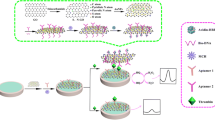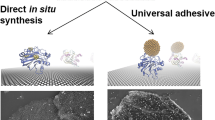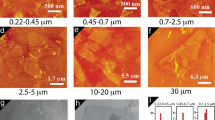Abstract
We report on an electrochemical method for the determination of the activity of trypsin. A multi-functional substrate peptide (HHHAKSSATGGC-HS) is designed and immobilized on a gold electrode. The three His residues in the N-terminal are able to recruit thionine-loaded graphene oxide (GO/thionine), a nanocover adopted for signal amplification. Once the peptide is cleaved under enzymatic catalysis by trypsin (cleavage site: Lys residue), the His residues leave the electrode, and the GO/thionine cannot cover the peptide-modified electrode anymore. Thus, the changes of the electrochemical signal of thionine, typically acquired at a voltage of -0.35 V, can be used to determine the activity of trypsin. A detection range of 1 × 10−4 to 1 U, with a detection limit of 3.3 × 10−5 U, can be achieved, which is better than some currently available methods. In addition, the method is highly specific, facile, and has the potential for the detection of trypsin-like proteases.

Graphene oxide was adopted as a nanocover for the development of a sensitive electrochemical method to detect the activity of trypsin.







Similar content being viewed by others
References
Lin YY, Chapman R, Stevens MM (2014) Label-free multimodal protease detection based on protein/perylene dye coassembly and enzyme-triggered disassembly. Anal Chem 86:6410
Olsen JV, Ong SE, Mann M (2004) Trypsin cleaves exclusively C-terminal to arginine and lysine residues. Mol Cell Proteomics 3:608
Hirota M, Ohmuraya M, Baba H (2006) The role of trypsin, trypsin inhibitor, and trypsin receptor in the onset and aggravation of pancreatitis. J Gastroenterol 41:832
Gao X, Tang GC, Li Y, Su XG (2012) A novel optical nanoprobe for trypsin detection and inhibitor screening based on Mn-doped ZnSe quantum dots. Anal Chim Acta 743:131
Baustert JH, Wolfbeis OS, Moser R, Koller E (1988) Fluorometric continuous kinetics assay of α-chymotrypsin using protease substrates possessing long-wave excitation and emission maxima. Anal Biochem 171:393
Guarise C, Pasquato L, De Filippis V, Scrimin P (2006) Gold nanoparticles-based protease assay. Proc Natl Acad Sci U S A 103:3978
Wang YY, Zhang Y, Liu B (2010) Conjugated polyelectrolyte based fluorescence turn-on assay for real-time monitoring of protease activity. Anal Chem 82:8604
Zhu Q, Zhan RY, Liu B (2010) Homogeneous detection of trypsin in protein mixtures based on fluorescence resonance energy transfer between anionic conjugated polymer and fluorescent probe. Macromol Rapid Commun 31:1060
Xu JP, Fang Y, Song ZG, Mei J, Jia L, Qin AJ, Sun JZ, Ji J, Tang BZ (2011) BSA-tetraphenylethene derivative conjugates with aggregation-induced emission properties: fluorescent probes for label-free and homogeneous detection of protease and alpha 1-antitrypsin. Analyst 136:2315
Hu LZ, Han S, Parveen S, Yuan YL, Zhang L, Xu GB (2012) Highly sensitive fluorescent detection of trypsin based on BSA-stabilized gold nanoclusters. Biosens Bioelectron 32:297
Zaccheo BA, Crooks RM (2011) Self-powered sensor for naked-eye detection of serum trypsin. Anal Chem 83:1185
Dong MM, Qi HL, Ding SG, Li M (2015) Electrochemical determination of trypsin using a heptapeptide substrate self-assembled on a gold electrode. Microchim Acta 182:43
Morales-Narvaez E, Merkoci A (2012) Graphene oxide as an optical biosensing platform. Adv Mater 24:3298
Kong FY, Li XR, Zhao WW, Xu JJ, Chen HY (2012) Graphene oxide-thionine-Au nanostructure composites: preparation and applications in non-enzymatic glucose sensing. Electrochem Commun 14:59
Geim AK (2009) Graphene: status and prospects. Science 324:1530
Feng LY, Wu L, Qu XG (2013) New horizons for diagnostics and therapeutic applications of graphene and graphene oxide. Adv Mater 25:168
Chung C, Kim YK, Shin D, Ryoo SR, Hong BH, Min DH (2013) Biomedical applications of graphene and graphene oxide. Acc Chem Res 46:2211
Lu CH, Yang HH, Zhu CL, Chen X, Chen GN (2009) A graphene platform for sensing biomolecules. Angew Chem Int Ed 48:4785
He SJ, Song B, Li D, Zhu CF, Qi WP, Wen YQ, Wang LH, Song SP, Fang HP, Fan CH (2010) A graphene nanoprobe for rapid, sensitive, and multicolor fluorescent DNA analysis. Adv Funct Mater 20:453
Liu M, Song JP, Shuang SM, Dong C, Brennan JD, Li YF (2014) A graphene-based biosensing platform based on the release of DNA probes and rolling circle amplification. ACS Nano 8:5564.34
Zhang Z, Luo LQ, Zhu LM, Ding YP, Deng DM, Wang ZX (2013) Aptamer-linked biosensor for thrombin based on AuNPs/thionine-graphene nanocomposite. Analyst 138:5365
Wang Y, Li ZH, Hu DH, Lin CT, Li JH, Lin YH (2010) Aptamer/graphene oxide nanocomplex for in situ molecular probing in living cells. J Am Chem Soc 132:9274
Wei Q, Mao KX, Wu D, Dai YX, Yang JA, Du B, Yang MH, Li H (2010) A novel label-free electrochemical immunosensor based on graphene and thionine nanocomposite. Sensors Actuators B Chem 149:314
Zhu LM, Luo LQ (2012) DNA electrochemical biosensor based on thionine-graphene nanocomposite. Biosens Bioelectron 35:507
Xia F, White RJ, Zuo XL, Patterson A, Xiao Y, Kang D, Gong X, Plaxco KW, Heeger AJ (2010) An electrochemical supersandwich assay for sensitive and selective DNA detection in complex matrices. J Am Chem Soc 132:14346
Liu SF, Liu T, Wang L (2015) Label-free, isothermal and ultrasensitive electrochemical detection of DNA and DNA 3′-phosphatase using a cascade enzymatic cleavage strategy. Chem Commun 51:176
Gerasimov JY, Lai RY (2010) An electrochemical peptide-based biosensing platform for HIV detection. Chem Commun 46:395
Zhang M, Yin BC, Wang XF, Ye BC (2011) Interaction of peptides with graphene oxide and its application for real-time monitoring of protease activity. Chem Commun 47:2399
Rajesh C, Majumder C, Mizuseki H, Kawazoe Y (2009) A theoretical study on the interaction of aromatic amino acids with graphene and single walled carbon nanotube. J Chem Phys 130:124911
Meyer JC, Geim AK, Katsnelson MI, Novoselov KS, Booth TJ, Roth S (2007) The structure of suspended graphene sheets. Nature 446:60
Luo ZT, Lu Y, Somers LA, Johnson ATC (2009) High yield preparation of macroscopic graphene oxide membranes. J Am Chem Soc 131:898
Arya SK, Pandey P, Singh SP, Datta M, Malhotra BD (2007) Dithiobissuccinimidyl propionate self assembled monolayer based cholesterol biosensor. Analyst 132:1005
Miao P, Liu L, Nie YJ, Li GX (2009) An electrochemical sensing strategy for ultrasensitive detection of glutathione by using two gold electrodes and two complementary oligonucleotides. Biosens Bioelectron 24:3347
Liang RP, Tian XC, Qiu P, Qiu JD (2014) Multiplexed electrochemical detection of trypsin and chymotrypsin based on distinguishable signal nanoprobes. Anal Chem 86:9256
Acknowledgments
This work is supported by the National Natural Science Foundation of China (Grant No. 31200742).
Author information
Authors and Affiliations
Corresponding author
Rights and permissions
About this article
Cite this article
Chen, G., Shi, H., Ban, F. et al. Determination of trypsin activity using a gold electrode modified with a nanocover composed of graphene oxide and thionine. Microchim Acta 182, 2469–2476 (2015). https://doi.org/10.1007/s00604-015-1601-x
Received:
Accepted:
Published:
Issue Date:
DOI: https://doi.org/10.1007/s00604-015-1601-x




